Behind the scenes of 'the show': Deconstructing a baseball telecast
It's a day before the All-Star break, a cloudless Sunday morning, and I'm in the NBC Sports Chicago broadcast booth, situated between decks at Guaranteed Rate Field. Sunlight is pouring in from the east, so a curtain is drawn to eliminate the backlight for the pregame introduction play-by-play voice Jason Benetti and analyst Steve Stone will record shortly.
Chris Withers, the telecast's producer, is in the booth, too. While Benetti and Stone are the faces and voices of the broadcast, Withers leads the production efforts behind the scenes.
Flanking Benetti's chair are four TV monitors, one to his left and right at desk height, and two below desk level to his left and right. They each have different purposes, offering views of both the real-time and delayed telecast feeds, a screen for scripts to read, and another to view replays and graphics that are in the queue. The lower monitor to his right is secured via duct tape atop an orange Gatorade cooler.
There's a fifth screen: Benetti's laptop. A FanGraphs page is open, a common resource for him. He's going over notes and entering names into his scorebook.
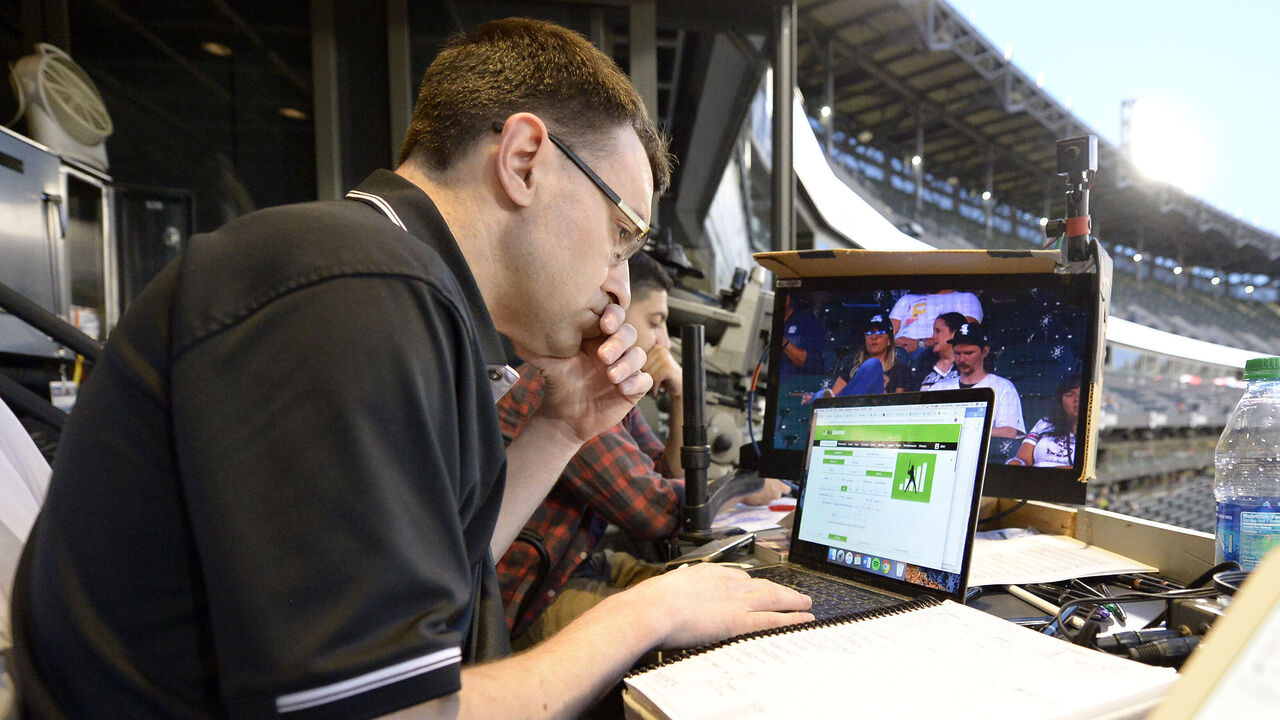
Also before him on the desk is the oldest of the technologies present: a five-inch square metal box that features two buttons: one cuts his mic if he needs to clear his throat, the other allows him to speak to the truck and not be heard on the broadcast.
"There are some old-school boxes that have one button and you have to cough in the producer's ear," Benetti said.
"I'm a big fan of that," Withers quipped. "A really big fan."
Like good teams, they have chemistry. It's been a long first half for everyone in White Sox Nation, but everyone's in good spirits before their final first-half broadcast.
Benetti, 39, possesses a rich voice and wonderful wit, in addition to deep baseball knowledge. His entrance into broadcasting was serendipitous. He played the tuba in the band at Homewood-Flossmoor High School, located in the southern Chicago suburbs about 25 miles from Guaranteed Rate Field, but he struggled to shoulder it in the marching band due to limitations from cerebral palsy. The band director suggested he announce the band's set during the football games. A star was born.
Withers, 43, always wanted to work in TV. His earliest memories include creating sports and news reports for his second-grade class. When he went to college at St. Cloud State in Minnesota, he thought he wanted to be an on-air talent. But after calling a few games, he grew tired of having better ideas than his producer. He went to work behind the scenes, and never left.
Stone, 76, won 107 games in an 11-year major-league pitching career, earning the AL Cy Young award in 1980 with Baltimore. He played three seasons for each of Chicago's teams and started calling Cubs games with Harry Caray in 1983. He's been in the White Sox booth since 2009, first with Hawk Harrelson and now with Benetti.
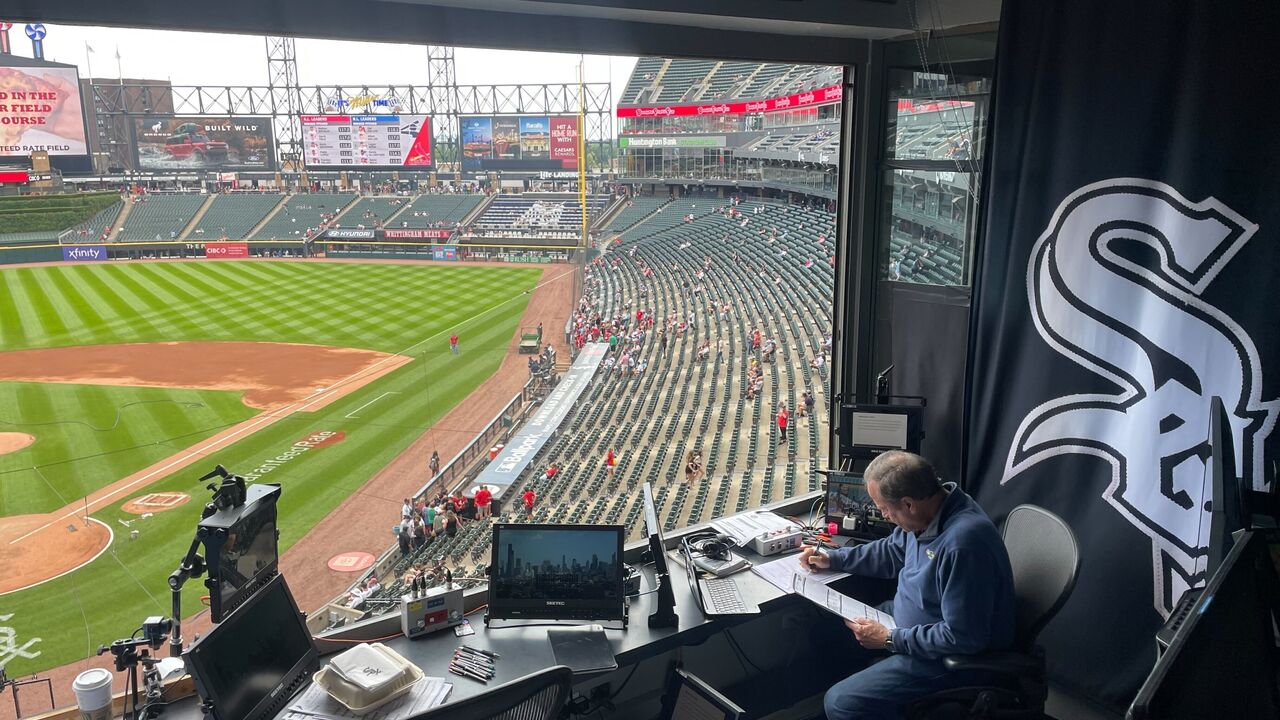
Withers points out a relatively new element added to the booth: peering around one of the monitors to Benetti's left is the "snoop" camera, which spies on Benetti and Stone throughout a broadcast. It's typically employed to capture moments of emotion from the announcers during a dramatic moment in the game, but they've found it's also useful for non-verbal communication between the announcers and the technical team during games. While we don't hear or see much of it as an audience, Withers and Benetti are communicating constantly.
I'm here because these local broadcasts matter.
While fans have different choices in consuming print and digital media, the TV broadcast is where all fans gather to watch the game if they don't buy a ticket. And there's only one in-market option for all those games that aren't televised nationally. The local broadcast is the one fans will likely spend the most time with compared to any other media product related to the club. The TV broadcast perhaps carries the most influence over what fans think and know about the team. It's why some ownership groups are so concerned with controlling the message, like the recent incident in Baltimore shows.
We want broadcasts to inform and entertain, and I wanted to understand how a quality one is orchestrated. The NBC Sports Chicago crew does it well. It polled as the sixth-best broadcasting team in the majors, according to Awful Announcing's most recent rankings, and has climbed in the polling more than just about any broadcast team since the middle of the last decade.
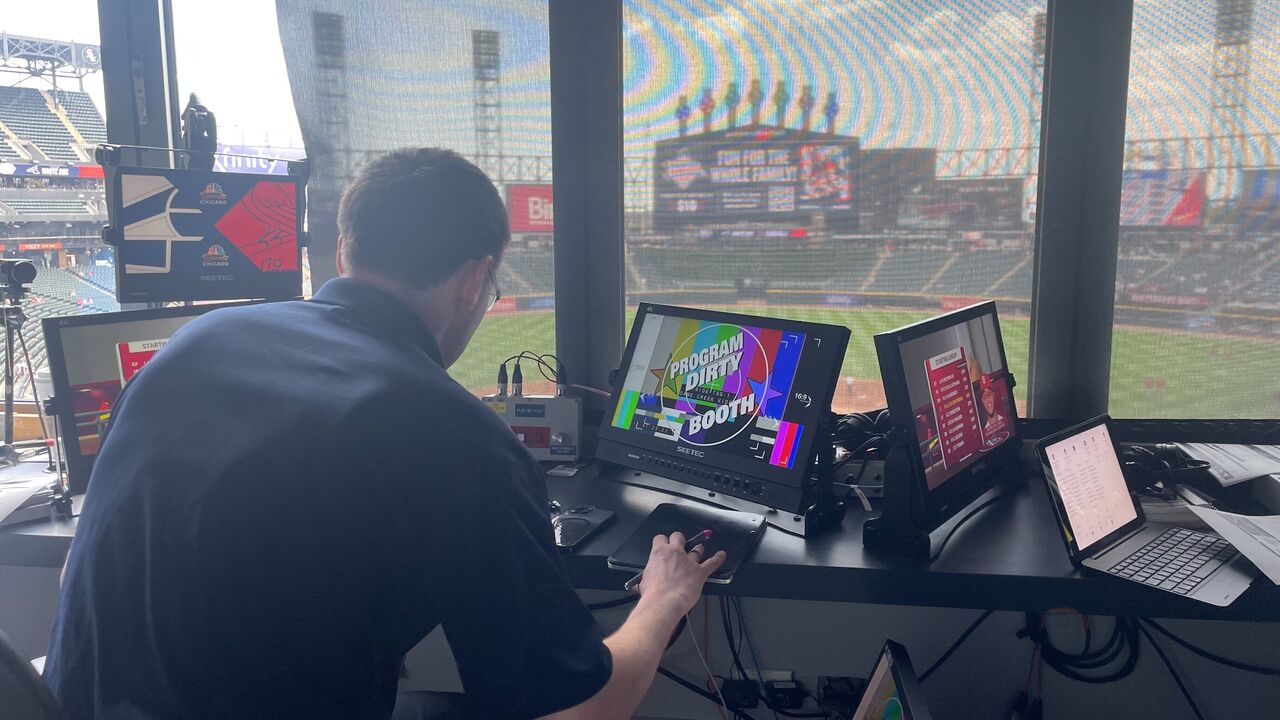
I asked Withers about the responsibility of putting on a broadcast, what he calls their "show."
"I love the responsibility," Withers said. "One thing I take a lot of pride in with our show is I think there is something for every fan, because, I do understand there are a lot of different baseball fans. There are, quote-unquote, traditionalists. I hate that term, but they just want batting averages and RBIs. They just want to see the play. There are the analytics folks, which probably are more skewed towards how Jason and I like to do things with exit velocity and, you know, expected slugging percentage and things like that. There's a crowd for that. But if you don't like one graphic we do, give us another batter. We'll give you something you do like.
"It took me a while to mature, and also working with Jason, to understand this isn't about me, this isn't about us. It's not for me to decide what the fans should like … We're going to give you every angle of it."
First inning: 'Except this season'
The production truck is separate from the stadium, situated in an adjacent parking lot beyond the right-field corner. It's a nondescript trailer with a white, metal corrugated exterior. It's where I'll spend the majority of the game.
Open the door, cross the threshold, and all the afternoon sunlight vanishes in the windowless space. There's dim light, which comes from a wall of flat-screen monitors: five rows of them, eight monitors per row. The glowing wall shows various camera feeds, replay, and graphics options. There are 22 cameras at the ballpark, 12 with their own operators, while the others are fixed or robotic. All those inputs feed here.
Withers, after his pregame meeting in the booth, is now charged with making sense of all this madness, narrowing down what from this wall of screens ought to be placed on the one screen viewers are watching. This is his command center; he's like a submarine captain surrounded by fire control and quartermasters. There's tension. Pressure to make timely decisions. Battle station-like lighting - but without the threat of deadly conflict.

There are two rows of personnel in the truck. Withers is in the front row seated next to the program director, who assists him in executing his commands and vision. Everyone is focused - no one is on their phones.
Before the game, decisions are made by Withers and other team members, like Benetti and Stone, on what to tell viewers between pitches. They can't control the action on the field, but they do control what they talk about between pitches.
Before this game, they decided they wanted to include one unusual statistic: the White Sox are 0-9 in games when their pitchers strike out 14 or more opponents. The graphics team built an on-screen table to accompany the discussion. And at the right time, early in the game, they want to go to the graphic.
So, live on the air in the first inning, Benetti tees up the research.
"The Sox staff lead the majors in strikeouts, and the Sox are 0-9 when striking out 14 or more," Benetti says between offerings from White Sox starting pitcher Lucas Giolito. "That is insane."
Says Stone: "I don't think you're going to see that ever again."
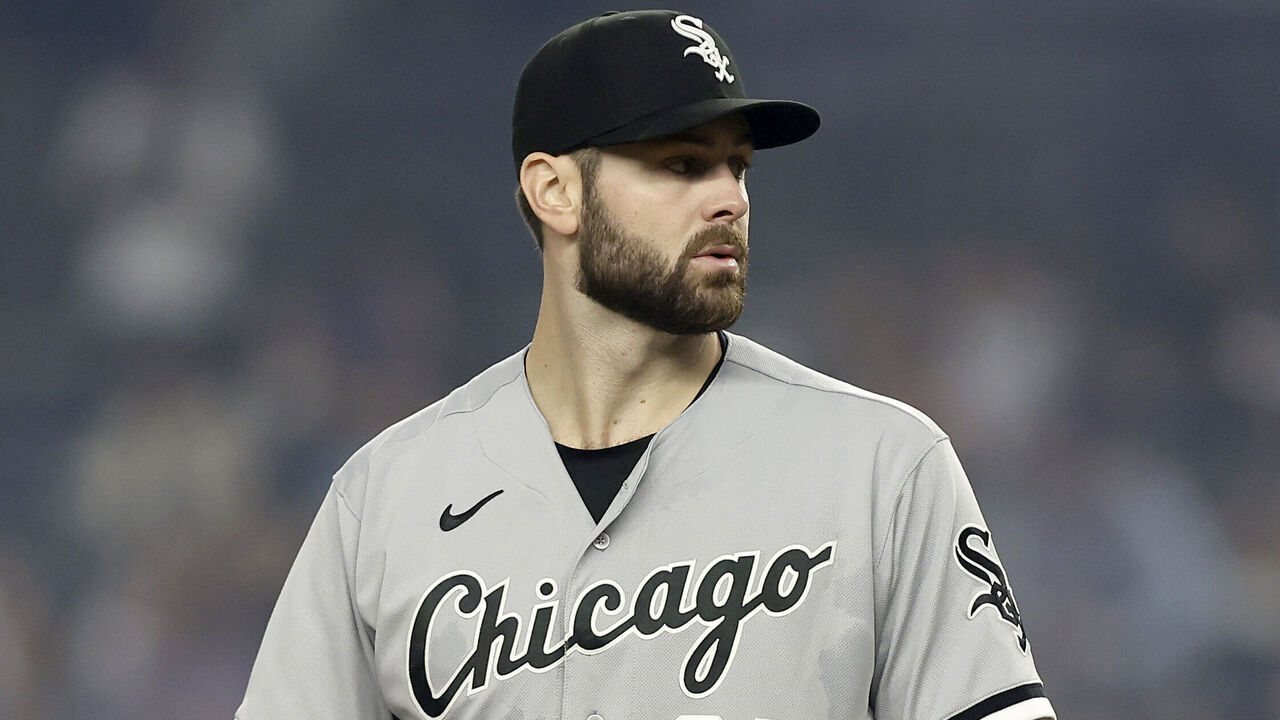
In the truck, Withers makes a request: "7621 please, 7621." His voice isn't quite at shout volume, but he's loud enough to be heard clearly. Before him is a sheet with four-digit codes for all the custom images, promos, and everything else they're trying to squeeze in between today's action.
Amid the wall of screens before Withers, the graphic appears on a monitor labeled "Font 2." The screen offers a final check to make sure it's the right graphic, and that there are no errors in it before it goes live.
Benetti says on air: "You won't be surprised to know that it is very rare that you don't win those games."
He turns to Stone: "What would you say the winning percentage is?"
"Seven-fifty, .780, something like that?" Stone asks.
Withers fires off the order to display the graphic: "Font 2 after the pitch." The pitch is thrown.
"Font 2, Font 2," Withers says with urgency. The director moves the graphic to live TV.
The answer to Benetti's question appears, and he reads the stat: a .727 winning percentage.
"You almost always win these kinds of games," Benetti says.
"Except this year," Stone says.
Echoes Benetti: "Except this year."
Second inning: When to inform
It's the top of the second inning and Giolito tosses a borderline pitch called a strike.
Stone notes it on the live broadcast. "Probably an inch or so off the outside corner but too close to take."
Withers seizes the moment. There's another element they often try to get to early during a broadcast to give the viewer relevant information: a heat map showing the home-plate umpire's balls and strikes tendencies.
In the truck, Withers addresses one of his staffers behind him: "Font 1 if we get a foul ball."
The monitor labeled Font 1 shows the heat map of umpire Alfonso Marquez's strike-calling bias waiting to be delivered into living rooms across the Chicago TV market. They're waiting for a foul ball; it'll allow for a bit more time between pitches to explain the chart. Cardinals catcher Willson Contreras fouls away the next pitch.
Withers presses the button that allows him to speak into Benetti's and Stone's ears: "Here's that scouting report."
The scouting report appears on the live broadcast.
Says Benetti on the broadcast to Stone: "Here's that scouting report you were talking about and it's a good catch."
Stone had referenced the wider portion of the strike zone earlier.
"Yeah, with the right-handed batters, you have a little bit more of that encouraging zone on the outside part of the plate," Stone says.
Withers again pushes the button on his control board to speak directly to Stone and Benetti: "Good stuff, guys."
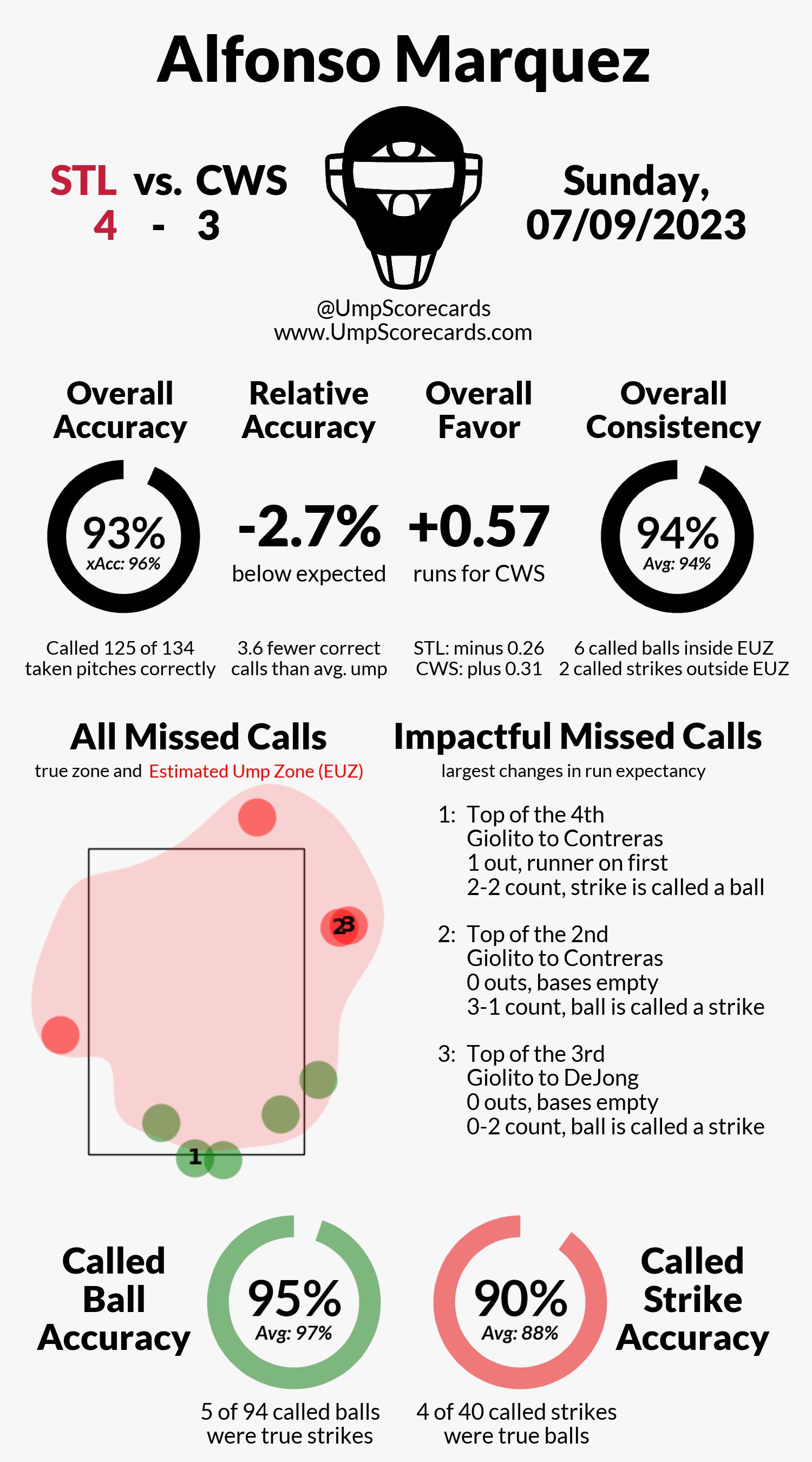
Third inning: A highlight
Replay is at the heart of the production of a broadcast.
The bottom row of the wall of flat-screen monitors in the truck are nearly all dedicated to replay, and most of those flat screens are separated into four squares showing different vantage points or speeds of replay. Each replay monitor is labeled by color: red, green, blue, yellow, gold, silver, purple, and orange. Almost every action on the field captured during the game by the 22 cameras is being recorded and can be spliced into replay if needed.
Replay is essential, and there's an art to it.
In the bottom of the third inning, when White Sox shortstop Tim Anderson grounds a ball back to Cardinals pitcher Steven Matz, it results in a close play at first base. The umpire rules Anderson out to end the frame.
"Orange is next," Withers says.
Withers' request means the orange-labeled replay needs to be queued, ready to be played live.
The orange replay shows the play at first base.
"He's going to be out," Withers says.
It's quiet for a moment, then Withers asks for orange to go live.
The game is paused briefly as the White Sox decide whether to challenge. If they do, Withers will show several more angles; he readies a sequence in case it's needed.
But for now, the broadcast truck shows White Sox manager Pedro Grifol holding up his hand; he's waiting for his own replay coach to weigh in on the phone.
Someone in the back of the truck exclaims: "Oooooh!"
What no one noticed live, but what was picked up by one of the crew members creating a replay, is that Matz made an incredible play to record the out:
Steven Matz deflects the ball, loses his glove and still wins the footrace to the bag! pic.twitter.com/FATWlLIrOe
— MLB (@MLB) July 9, 2023
But there's no time to show that right now. The White Sox signaled they won't challenge. The inning is over.
"This is a roll out. Music!" Withers calls.
And they're off to commercial break, but there's no reprieve. The crew's reviewing replay options to show coming out of the break. The story of that play is yet to be fully told.
Seeing the replay during the break, Benetti says through the truck's speaker: "That's ridiculous."
What's revealed upon second examination is that the deflected batted ball knocked Matz's glove from his right hand, spinning it into the air. Remarkably, Matz caught his glove, slipped it back on as he ran to cover first base, and then captured the toss to beat Anderson to the bag.
Withers later explains what skills are key in his role: "Creativity, decision-making, quick-thinking, communicating quickly but clearly."
Withers comes up with a plan. When they return from break, he wants to go directly into the replay of Matz's glove. There are about 10 seconds between the end of the final commercial and first pitch. Missing a pitch is a cardinal sin.

Withers finishes the countdown: " … Three, two, one. We're back, go ahead and spin."
In transitioning from the break, the broadcast is frozen for a split second as the pitch is about to be released from Matz's hand. The slow-motion replay begins, with Benetti addressing the audience over the replay. "A defensive play with a magic trick in the middle," Benetti says on air.
The replay is completed. The inning's first pitch is thrown.
Withers instructs a new order: "Green real-time after the pitch."
Each replay can be played with real-time speed and slow-motion options. A few select cameras have super slo-mo options. Green is the dugout camera angle from the first-base side. The play is shown once more, this time in real time.
"That's awesome," Withers says.
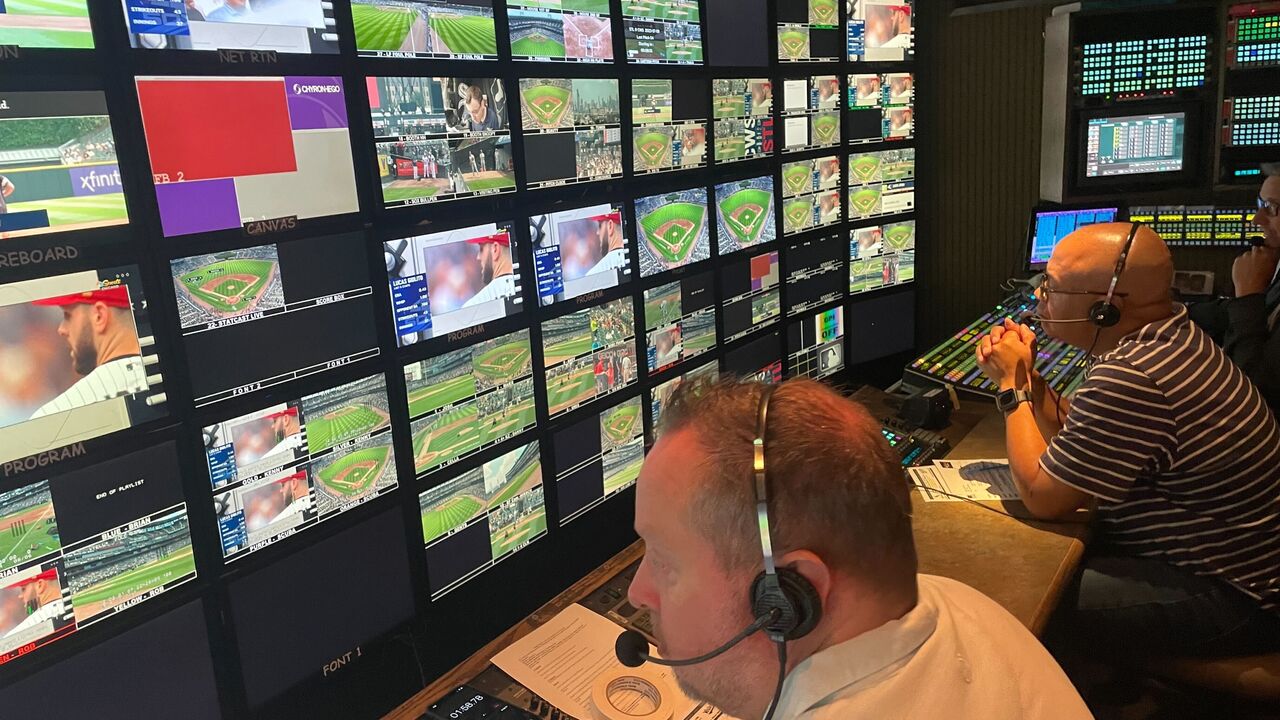
After the game, I asked Withers about the replay sequence.
"The main thing about that play, especially since it was with two outs, was, 'Is he out or safe?' You'll see so often in baseball this replay routine: 'Here's the pitch first. Here's this …' None of that matters," he says. "What I love that we do really well is we go right to the play at the base. That first look, you make sure it's the look that definitely tells you. It definitively told us he's out. I saw that they started the clock for commercial break. So I had one (replay) look going there. Then that sequence coming out of the break. That sequence was one that I really liked."
Fourth inning: Safety net
Withers and his team rarely seem panicked. It's like a well-run kitchen during a dinner rush.
There was one moment of stress on this day, though.
The crew was seconds from coming out of a break, with a graphic ready that compared the pace of play from the first half of last year versus this season. It was another element of their pregame research.
Withers speaks into his mic to Benetti: "This includes all of the games through yesterday."
Less than a minute before the graphic was to go live, Withers notices a typo. Instead of a colon between the hours and minutes for the average time of a game this season, there's a period, making it look like an ERA. The error is alerted. James, the graphics whiz, is on it.
Withers counts down as they return to air: "10, nine, eight, seven …"
"Possibly most important is becoming even more calm when things get really hectic or hairy," Withers says later. "The situation is already tense, and if I add to it by panicking, it makes the situation worse."
Another monitor on the wall of screens is labeled "Canvas." It shows visual elements teams are readying. It's blank.
"Six, five, four …"
A new graphic appears on "Canvas" with a colon between hours and minutes.
"Here's James," someone says.
"Good hustle. Go James!" Withers says.
Cheers erupt in the truck.
"And we're back. Go ahead," Withers says into his mic to Benetti.
Benetti's voice goes live: "Third inning brought to you by Hyundai. Game time by decade. …"
The graphic appears on screen.
Asks Benetti of Stone: "This is as short as games have been since you were how old?"
There's laughter in the truck.
Fifth inning: A new variable
The one new variable in all production trucks this year: the pitch clock.
The on-field pitch clock is synchronized to one in the truck that counts down in red digital numbers, to add another layer of pressure.
I asked Withers about this adjustment prior to first pitch.
"I went in freaked out," Withers said of this season. "I think we adapted very quickly. I think we overcompensated. Because the first week, I was like, 'Oh, we, like, we still have time. There's still time for us to do stuff.' We still tell stories."
There's one change White Sox viewers might have noticed: there are no replays immediately after home runs.
"We just stay with the moment and take them into the dugout and I get back to the replay (later)," Withers said. "That's a change for me. I've never done that in my career."
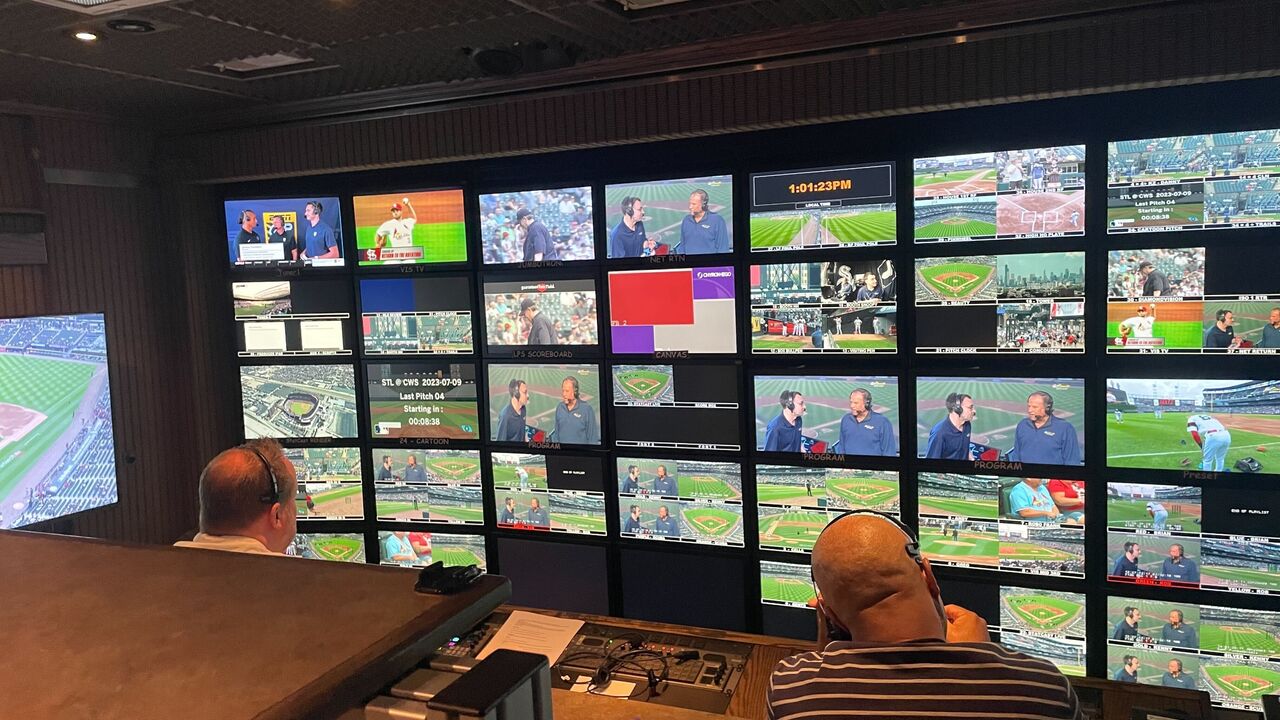
Sixth inning: Placing the clock
One of the main conversations related to the clock entering the season was about where to place it on the screen for the viewer.
Each broadcast displays it on different parts of the screen, often in the score bug, and it appears at different times in its countdown.
During a White Sox telecast, the clock appears on the viewer's TV with 12 seconds remaining. And it's not in the score bug, but just to the right of the pitching rubber. The countdown digits are in white, outlined in a white circle. It subtly blends in and is close to where the viewer's attention likely is.
"We're the only ones," Withers says of the look and placement. "I don't think it gets in the way. I don't want fans to divert their eyes. The pitch is coming, it's center frame. If you are interested in the clock, why look up at (a score bug). You can just keep your eyes there. It's right there on the mound."
Seventh inning: What just happened?
For the final three innings, I made my way back up to the booth.
With one out in St. Louis' seventh, Contreras is on first base. He's running on the pitch when Alec Burleson bloops a ball to shallow right field. Benetti's call: "There goes Contreras. This is blooped to right field, (Oscar) Colas coming in, and Colas is there.
"And Contreras is not."
Colas tossed to first base to complete the inning-ending double play. Contreras appeared to see the action unfold before him, but curiously kept running.
On the live broadcast feed, the focus was on Contreras slowly walking off the field, followed by a transition to a shot of Cardinals manager Oli Marmol. Marmol was emotionless. In the booth, Stone, Benetti, and I looked at each other in bemusement.
We then see the replay. Withers chose an angle from the robo camera behind the plate, which allowed for a view of the entire right half of the field. The entire play was captured.
Stone started speaking as the replay began, syncing up perfectly.
"We know it's a hit-and-run," he said. "(Contreras) seems to pick it up and then decides, somehow, 'You know what? I might as well go to third.'"
After the game, I ask Withers why he elected to show that replay angle.
"I will see other shows, so often, show me the swing, then show me a tight shot of a guy catching it," Withers said. "All I needed was the robo behind the plate because it kept everything in. It shows the swing. It shows Contreras was running. So that look, don't overthink it - it's not tight, it's not super slo-mo, it's not the sexiest look. It's all I need, though. I just need the look that is going to tell the right story."
Eighth inning: Ad libs
I've spent a lot of time in the road clubhouse at Progressive Field in Cleveland. The play-by-play voices for visiting teams aren't always present regularly. But Benetti is when the Sox are in town. Here's often there pregame, interacting with players, asking questions that might ultimately better inform the broadcast.
"I can go in and just explore whatever is sort of rolling around in my mind as a possible curiosity. It is like, 'Hey, what happened on that play?' Or we get a lot of mileage out of, 'Hey, I saw that shot of you smiling in the dugout. What were you doing?'" Benetti says before the game.
"(For example) in Kansas City, Tim (Anderson) and Salvador Perez were laughing at the plate and they're not really close after everything that happened, like with the Brad Keller situation and all that."
What were they laughing about?
'Well, (Zack) Greinke was grunting well after he released the baseball. Isn't that great? So, I'll watch for human reactions to go ask that sort of thing."
Third baseman Jake Burger (later traded to Miami) and Benetti had a running joke where Burger seemed to only homer when Benetti was on assignment for national broadcasts, his other gig.
"I saw him in the clubhouse today and he was like, 'Hey man, I'm trying to get to 20 before the break,'" Benetti said.
So, before the game, Benetti asked Stone if he wanted to call a Burger at-bat. Maybe he would bring better fortune. In the bottom of the seventh, Burger steps from the on-deck circle.
"And here is Burger," Benetti announces. "You want to do the at-bat?" Benetti asks Stone on the air. "See if he comes through?"
"Well, yeah, it was part of the plan. I was psyched up, I had done a lot of research in the interim," Stone says.
Stone starts his play-by-play call.
"He's got 19 and 41 on the power numbers and he has to lay off that slider away because it's a good one from (Dakota) Hudson. He takes one low and the count goes to 2-0, much to the advantage of Burger."
Playing analyst, Benetti interjects: "Maybe a fastball here because he is ahead?"
Stone: "Well, if he does, it's probably going to be away. "
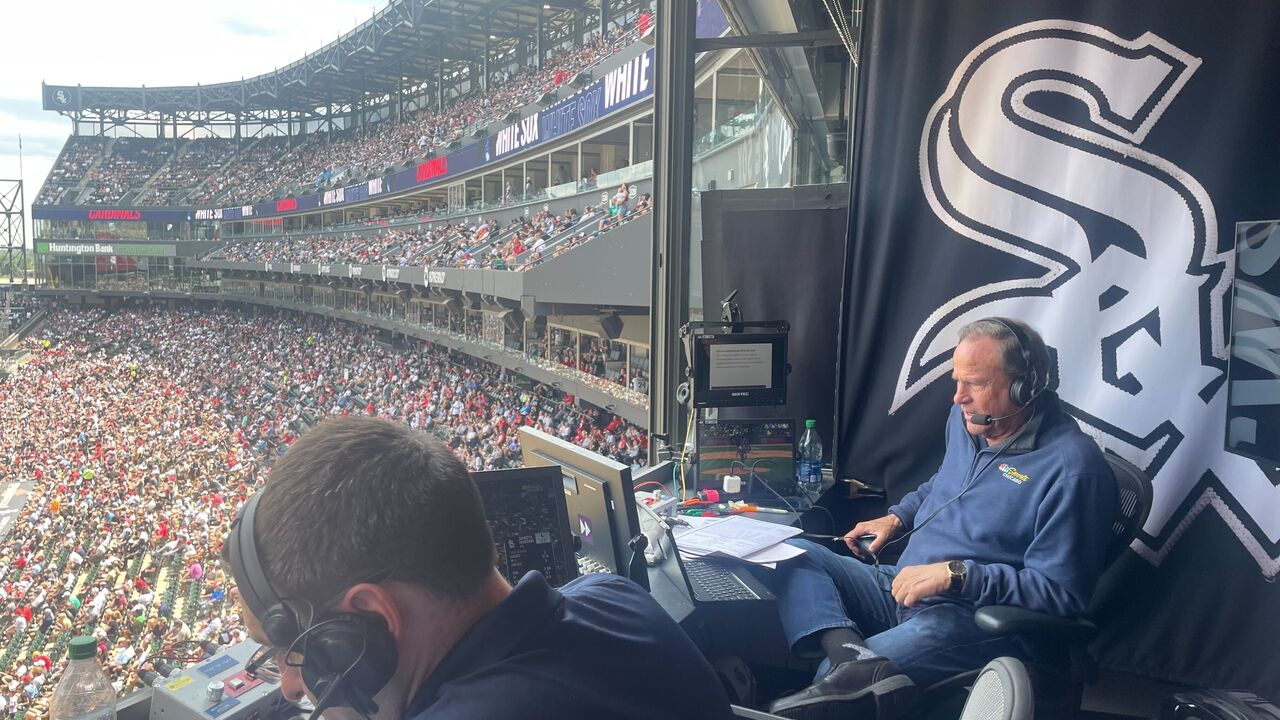
Sure enough, the next pitch was meant to be outside but drifted back over the plate for a called strike.
On the next pitch, Burger chops a ball up the third-base line.
"Jake is going to beat it out. No chance at all for (Nolan) Gorman. And that's a base hit, and I will be calling the rest of his at-bats for his entire career," Stone says.
"Well done, Steve," Benetti says.
Even when reversing roles, they never seem to step on each other's toes. They adjust and ad lib well. Last week, Benetti took over an entire broadcast flawlessly when Stone had to leave with illness. Benetti marveled before the game how well Stone gets in and out of his points quickly, concisely.
I asked Stone about this ability to boil his thoughts down in real time.
"I'm at 41 years in the television business, and I think it is certainly learned. But I think you have to understand the timing of the job, and realize you cannot bleed through into pitches," Stone says. "Play-by-play guys make their bones on home-run calls. You don't want to be making your point when the ball is sailing out of the ballpark. You also want to use as few words as you can to get across your point. Because if you use a lot of words all the time, the viewer cannot assimilate what you want to tell him."
Ninth inning and extras: Lemons? Lemonade
It's been a difficult season to be a White Sox fan. The team's underperforming. It sold at the deadline. Club vice president Ken Williams and GM Rick Hahn were dismissed by owner Jerry Reinsdorf. There's been reported dysfunction in the clubhouse, and Anderson got into a well-publicized brawl with Jose Ramirez in Cleveland. But the show must go on.
I asked Benetti how he balances objectivity with being the voice for a fan base, an issue that later blew up into a national talking point when the Orioles suspended play-by-play announcer Kevin Brown for a seemingly innocuous comment about Baltimore's lack of success playing in Tampa Bay in recent years. Benetti was outspoken in his support of Brown. Before that happened, he was circumspect in describing how he weighs things for himself.
"I'm getting to the age where I've lost a couple friends over the past few years. People have really hard jobs. I don't want to bring sadness," he says. "I just don't. So, like, there is truth, but I also think because we're in the television business, people can see when something has not gone well, when it's going haywire. And I'm not here to tell people that they're seeing something else, but I also don't need to say, you should have a bad day because of me. And that's not to protect the team. That's to protect all of our sensibilities in life. Life's hard enough, that's kind of what I'm saying."
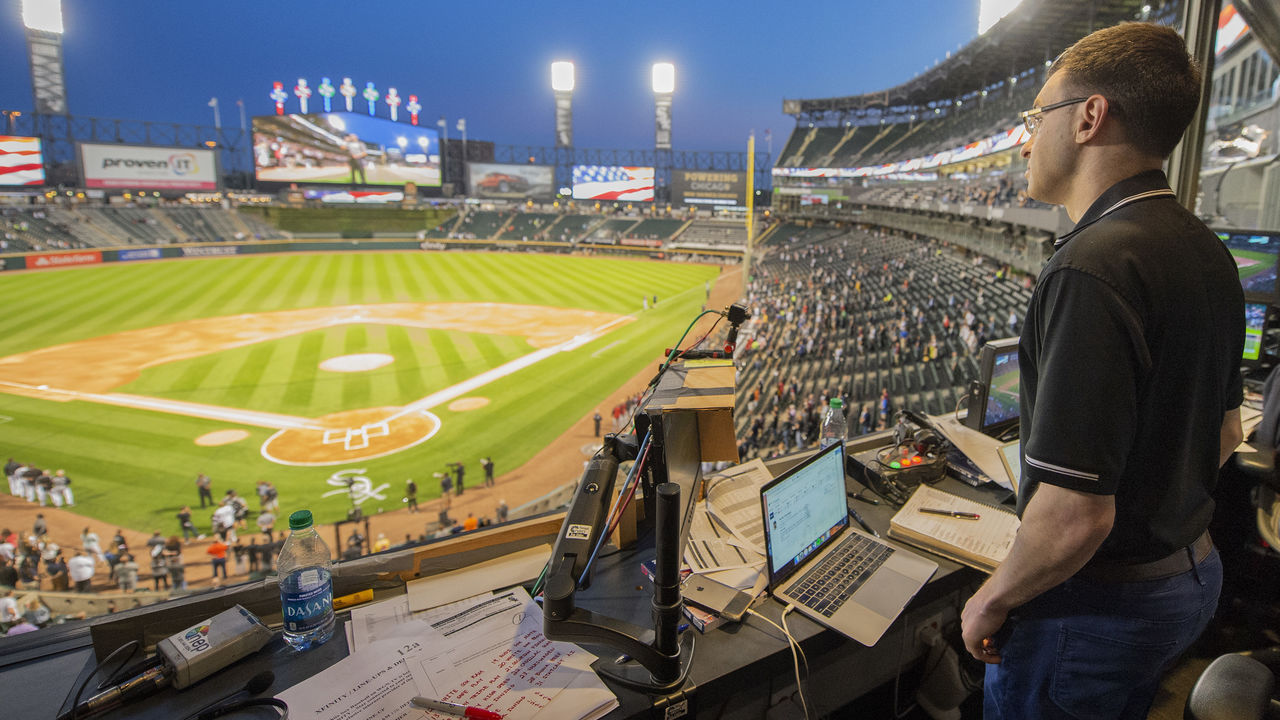
On this day, the White Sox surrendered a lead late and lost in 10 innings, with Anderson striking out to end it. Benetti wraps up the broadcast: "To our wonderful crew, for Chris Withers …"
The broadcast team departs for its break, to recharge from the first-half grind.
"Get your rest," Stone advises booth personnel before leaving.
I asked Benetti how he makes a season like this one interesting day after day when he's not always given much to work with.
"One of my law professors, Ralph Peeples at Wake Forest, passed away (recently). He and this other professor of mine were big baseball fans. So when I was at Syracuse (calling Triple-A games), they would come to Durham, and they would hang out with me. It was nice when I was working alone. I could talk to them," says Benetti, perhaps the only announcer in the game with a law degree.
"This one time, Syracuse went down 9-0 in the first inning at Durham. (Peeples) taps me on the shoulder and says, 'So, what else you got?' I think about it often. It was the first memory (after he died). But it's also good advice. What else you got? What are you going to do? It's there. Find it."
Travis Sawchik is theScore's senior baseball writer.